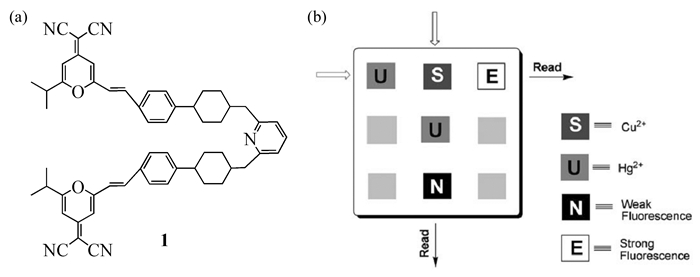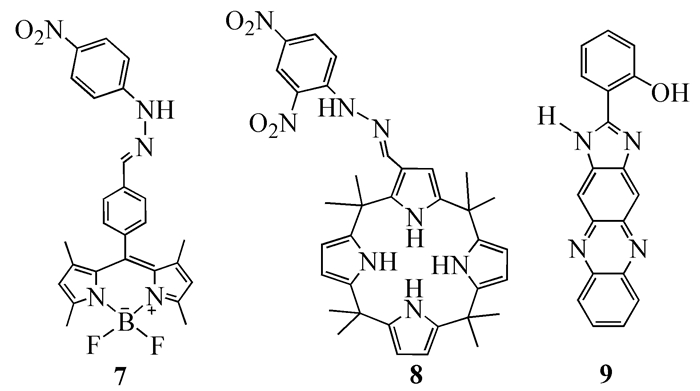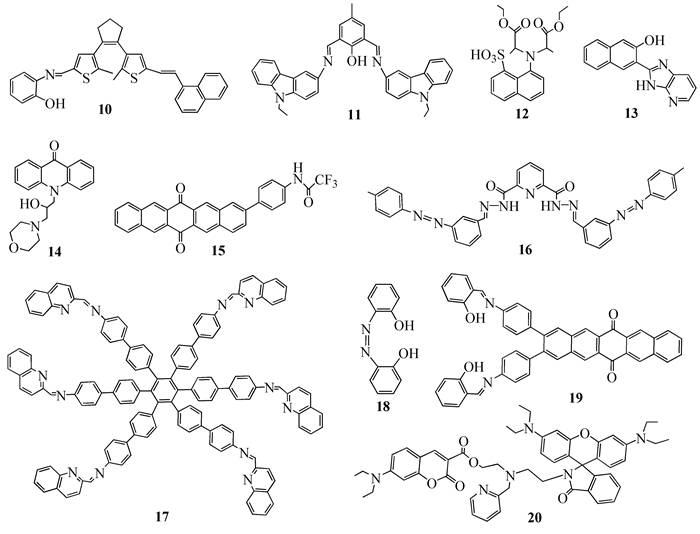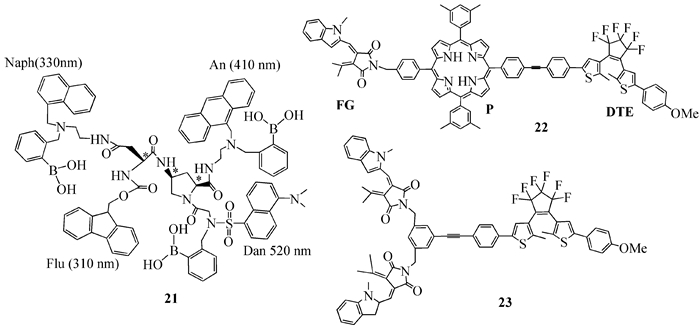Citation:
Li Qian. Research Progress in Molecular Keypad Lock Based on Optical Probes[J]. Chemistry,
;2018, 81(6): 493-500.

-
Molecular keypad locks as a new kind of molecular logic gate, its signal output depends not only on the proper combination of the inputs but also on the correct order, which could protect information at molecular level. Optical probes are predominantly attractive due to their simplicity, high degree of specificity, low detection limits, easy on-line analysis and especial colorimetric recognition and in situ detection. The molecular keypad locks based on optical probes, including cation input, anion input and cation/anion input keypad locks, etc are highlighted. In the end, the development tendency of molecular keypad locks is prospected.
-

-
- [1]
- [2]
-
[3]
J Andreasson, U Pischel. Chem. Soc. Rev., 2015, 44:1053-1069.
- [4]
- [5]
- [6]
-
[7]
O Lustgarten, L Motiei, D Margulies. ChemPhysChem, 2017, 18(13):1678-1687.
-
[8]
C P Carvalho, Z Domínguez, J P Da Silva et al. Chem. Commun., 2015, 51:2698-2701.
- [9]
-
[10]
L Wang, W Lian, H Liu. Chem. Eur. J., 2016, 22(14):4825-4832.
-
[11]
J Zhu, X Yang, L Zhang et al. Chem. Commun., 2013,49(48):5459-5461.
-
[12]
Z Zhou,Y Liu, S Dong. Chem. Commun., 2013, 49(30):3107-3109.
-
[13]
F Pu, Z Liu, J Ren et al. Chem. Commun., 2013, 49(23):2305-2307.
-
[14]
Y Liu, J Ren, Y Qin et al. Chem. Commun., 2012,48(6):802-804.
-
[15]
W Hong, Y Du, T Wang et al. Chem. Eur. J., 2012,18(47):14939-14942.
-
[16]
F Pu, Z Liu, X Yang et al. Chem. Commun., 2011, 47(21):6024-6026.
-
[17]
M Zhou, X Zheng, J Wang et al. Chem. Eur. J., 2010, 16(26):7719-7724.
-
[18]
J Halámek, T K Tam, G Strack et al. Chem. Commun., 2010,46(14):2405-2407.
-
[19]
W Sun, C Zhou, C Xu et al. Chem. Eur. J., 2008, 14(21):6342-6351.
-
[20]
G Strack, M Ornatska, M Pita et al. J. Am. Chem. Soc., 2008, 130(13):4234-4235.
-
[21]
D Margulies, C E Felder, G Melman et al. J. Am. Chem. Soc., 2007, 129(2):347-354.
-
[22]
Z Guo, W Zhu, L Shen et al. Angew. Chem. Int. Ed., 2007, 46(29):5549-5553.
-
[23]
X Chen, T Pradhan, F Wang et al. Chem. Rev., 2012,112(3):1910-1956.
-
[24]
Y Wang, Y Huang, B Li et al. RSC Adv., 2011, 1(7):1294-1300.
-
[25]
T Mistri, R Alam, R Bhowmick et al. Analyst, 2014, DOI:10.1039/C3AN02255B.
-
[26]
T Mistri, R Alam, R Bhowmick et al. New J. Chem., 2016, 40(1):330-339.
- [27]
-
[28]
S Chen, Z Guo, S Zhu et al. ACS Appl. Mater. Interf., 2013, 5(12):5623-5629.
-
[29]
J He, J He, T Wang et al. J. Mater. Chem. C, 2014, 2(36):7531-7540.
-
[30]
N Boens, V Leen, W Dehaen. Chem. Soc. Rev., 2012, 41(3):1130-1172.
-
[31]
Q Li, Y Yue, Y Guo et al. Sens. Actuat. B, 2012, 173:797-801.
- [32]
-
[33]
H Tavallali, G Deilamy-Rad, A Parhami et al. J. Hazard. Mater., 2014, 266:189-197.
- [34]
-
[35]
Q Zou, X Li, J Zhang et al. Chem. Commun., 2012, 48(15):2095-2097.
-
[36]
S Sharma, T Virk, C Pradeep et al. Eur. J. Inorg. Chem., 2017, (18):2457-2463.
-
[37]
M Suresh, A Ghosh, A Das. Chem. Commun., 2008, 44(33):3906-3908.
-
[38]
S Kumar, V Luxami, R Saini et al. Chem. Commun., 2009, 45(21):3044-3046.
-
[39]
P Singh, J Kaur, W Holzer et al. Sens. Actuat. B, 2010, 150:50-56.
-
[40]
V Bhalla, Roopa, M Kumar. Dalton Transac., 2013, 42(37):13390-13396.
-
[41]
M Kumar, A Dhir, V Bhalla. Org. Lett.,2009, 11(12):2567-2570.
-
[42]
K Rezaeian, H Khanmohammadi. Supramol. Chem., 2016, 28(3-4):256-266.
-
[43]
V Bhalla, V Vij, M Kumar et al. Org. Lett., 2012, 14(4):1012-1015.
- [44]
-
[45]
V Bhalla, Roopa, M Kumar. Org. Lett., 2012,14(11):2802-2805.
-
[46]
X Jiang, D Ng. Angew. Chem. Int. Ed., 2014, 53(39):10481-10484.
-
[47]
B Rout, P Milko, M Iron et al. J. Am. Chem. Soc., 2013, 135(41):15330-15333.
-
[48]
J Andréasson, S Straight, T Moore et al. Chem. Eur. J., 2009, 15(16):3936-3939.
-
[49]
J Andréasson, U Pischel, S Straight et al. J. Am. Chem. Soc., 2011, 133(30):11641-11648.
-

-
-
[1]
Yingpeng ZHANG , Xingxing LI , Yunshang YANG , Zhidong TENG . A pyrazole-based turn-off fluorescent probe for visual detection of hydrazine. Chinese Journal of Inorganic Chemistry, 2025, 41(7): 1301-1308. doi: 10.11862/CJIC.20250064
-
[2]
Yuting DU , Jing YUAN , Peiyao DENG . Synthesis and application of a fluorescent probe for the detection of reduced glutathione. Chinese Journal of Inorganic Chemistry, 2025, 41(7): 1331-1337. doi: 10.11862/CJIC.20240461
-
[3]
Qiang HU , Zhiqi CHEN , Zhong CHEN , Xu WANG , Weina WU . Pyridinium-chalcone-based ClO- fluorescent probe: Preparation and biological imaging applications. Chinese Journal of Inorganic Chemistry, 2025, 41(9): 1789-1795. doi: 10.11862/CJIC.20250086
-
[4]
Jinlong YAN , Weina WU , Yuan WANG . A simple Schiff base probe for the fluorescent turn-on detection of hypochlorite and its biological imaging application. Chinese Journal of Inorganic Chemistry, 2024, 40(9): 1653-1660. doi: 10.11862/CJIC.20240154
-
[5]
Jun LUO , Baoshu LIU , Yunchang ZHANG , Bingkai WANG , Beibei GUO , Lan SHE , Tianheng CHEN . Europium(Ⅲ) metal-organic framework as a fluorescent probe for selectively and sensitively sensing Pb2+ in aqueous solution. Chinese Journal of Inorganic Chemistry, 2024, 40(12): 2438-2444. doi: 10.11862/CJIC.20240240
-
[6]
Yanxi LIU , Mengjia XU , Haonan CHEN , Quan LIU , Yuming ZHANG . A fluorescent-colorimetric probe for peroxynitrite-anion-imaging in living cells. Chinese Journal of Inorganic Chemistry, 2025, 41(6): 1112-1122. doi: 10.11862/CJIC.20240423
-
[7]
Pengli GUAN , Renhu BAI , Xiuling SUN , Bin LIU . Trianiline-derived aggregation-induced emission luminogen probe for lipase detection and cell imaging. Chinese Journal of Inorganic Chemistry, 2025, 41(9): 1817-1826. doi: 10.11862/CJIC.20250058
-
[8]
Yu SU , Xinlian FAN , Yao YIN , Lin WANG . From synthesis to application: Development and prospects of InP quantum dots. Chinese Journal of Inorganic Chemistry, 2024, 40(11): 2105-2123. doi: 10.11862/CJIC.20240126
-
[9]
Benhua Wang , Chaoyi Yao , Yiming Li , Qing Liu , Minhuan Lan , Guipeng Yu , Yiming Luo , Xiangzhi Song . 一种基于香豆素氟离子荧光探针的合成、表征及性能测试——“科研反哺教学”在有机化学综合实验教学中的探索与实践. University Chemistry, 2025, 40(6): 201-209. doi: 10.12461/PKU.DXHX202408070
-
[10]
Fei Liu , Dong-Yang Zhao , Kai Sun , Ting-Ting Yu , Xin Wang . Comprehensive Experimental Design for Photochemical Synthesis, Analysis, and Characterization of Seleno-Containing Medium-Sized N-Heterocycles. University Chemistry, 2024, 39(3): 369-375. doi: 10.3866/PKU.DXHX202309047
-
[11]
Tingting Yu , Si Chen , Lianglong Sun , Tongtong Shi , Kai Sun , Xin Wang . Comprehensive Experimental Design for the Photochemical Synthesis, Analysis, and Characterization of Difluoropyrroles. University Chemistry, 2024, 39(11): 196-203. doi: 10.3866/PKU.DXHX202401022
-
[12]
Xuyu WANG , Xinran XIE , Dengke CAO . Photoreaction characteristics and luminescence modulation in phosphine-anthracene-based Au(Ⅰ) and Ir(Ⅲ) complexes. Chinese Journal of Inorganic Chemistry, 2025, 41(8): 1513-1522. doi: 10.11862/CJIC.20250113
-
[13]
Qi Wang , Yicong Gao , Feng Lu , Quli Fan . Preparation and Performance Characterization of the Second Near-Infrared Phototheranostic Probe: A New Design and Teaching Practice of Polymer Chemistry Comprehensive Experiment. University Chemistry, 2024, 39(11): 342-349. doi: 10.12461/PKU.DXHX202404141
-
[14]
Shuang Meng , Haixin Long , Zhou Zhou , Meizhu Rong . Inorganic Chemistry Curriculum Design and Implementation of Based on “Stepped-Task Driven + Multi-Dimensional Output” Model: A Case Study on Intermolecular Forces. University Chemistry, 2024, 39(3): 122-131. doi: 10.3866/PKU.DXHX202309008
-
[15]
Meirong HAN , Xiaoyang WEI , Sisi FENG , Yuting BAI . A zinc-based metal-organic framework for fluorescence detection of trace Cu2+. Chinese Journal of Inorganic Chemistry, 2024, 40(8): 1603-1614. doi: 10.11862/CJIC.20240150
-
[16]
Yuan ZHU , Xiaoda ZHANG , Shasha WANG , Peng WEI , Tao YI . Conditionally restricted fluorescent probe for Fe3+ and Cu2+ based on the naphthalimide structure. Chinese Journal of Inorganic Chemistry, 2025, 41(1): 183-192. doi: 10.11862/CJIC.20240232
-
[17]
Shuwen SUN , Gaofeng WANG . Design and synthesis of a Zn(Ⅱ)-based coordination polymer as a fluorescent probe for trace monitoring 2, 4, 6-trinitrophenol. Chinese Journal of Inorganic Chemistry, 2025, 41(4): 753-760. doi: 10.11862/CJIC.20240399
-
[18]
Zhifeng CAI , Ying WU , Yanan LI , Guiyu MENG , Tianyu MIAO , Yihao ZHANG . Effective detection of malachite green by folic acid stabilized silver nanoclusters. Chinese Journal of Inorganic Chemistry, 2025, 41(5): 983-993. doi: 10.11862/CJIC.20240394
-
[19]
Wei GAO , Meiqi SONG , Xuan REN , Jianliang BAI , Jing SU , Jianlong MA , Zhijun WANG . A self-calibrating fluorescent probe for the selective detection and bioimaging of HClO. Chinese Journal of Inorganic Chemistry, 2025, 41(6): 1173-1182. doi: 10.11862/CJIC.20250112
-
[20]
Lei ZHANG , Cheng HE , Yang JIAO . An azo-based fluorescent probe for the detection of hypoxic tumor cells. Chinese Journal of Inorganic Chemistry, 2025, 41(6): 1162-1172. doi: 10.11862/CJIC.20250081
-
[1]
Metrics
- PDF Downloads(4)
- Abstract views(670)
- HTML views(61)

 Login In
Login In
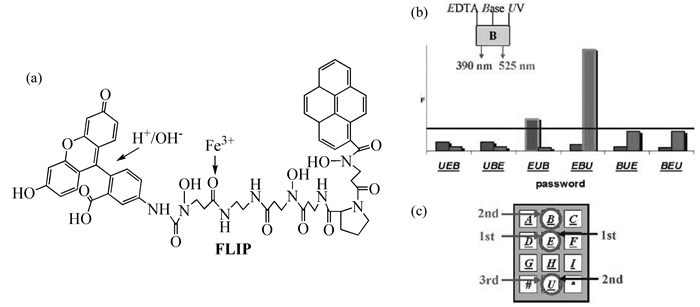




 DownLoad:
DownLoad:
